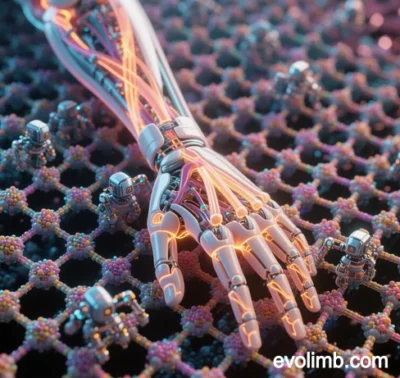
Evo Limb: Breakthroughs in Bionic Prosthetics, Exoskeletons, and Biohybrid Technologies
The convergence of neuroscience, materials engineering, and artificial intelligence has propelled bionic prosthetics and exoskeletons into a new era of bioelectronic symbiosis. This article explores three core technological advancements—bionic prosthetics, smart exoskeletons, and biohybrid interfaces—highlighting their scientific principles and cross-domain applications.
I. Bionic Prosthetics: From Dynamic Control to Multimodal Perception
- Neurally Controlled Bionic Systems:
- MIT Biohybrid Prosthetic: Combines regenerative tissue with titanium frameworks, enabling direct neural signal control via BION microchips. Its shape-memory alloy (SMA) joints mimic ankle biomechanics, reducing gait errors.
- Ottobock Symbionic Leg: Features energy-recovery systems that convert knee motion into electrical power. Its gradient carbon-fiber arch adapts to terrain slopes, minimizing fall risks.
- Multimodal Sensory Restoration:
- Tactile-Temperature Feedback: Devices like SEM Glove™ use microelectrode arrays to restore pressure, vibration, and temperature perception, enhancing environmental interaction.
- Quantum Tactile Sensors: Diamond-based probes detect neuron-level strain for ultra-early Parkinson’s diagnosis.
II. Smart Exoskeletons: From Industrial Aid to Neural Remodeling
- Industrial Exoskeletons:
- EVO Exoskeleton: Employs low-profile multi-link structures and modular harnesses to support overhead, cross-body, and rear-reaching tasks. Adaptive impedance control reduces muscle fatigue in factory workers.
- Medical Rehabilitation Exoskeletons:
- EksoNR: Integrates EMG/EEG signals to adjust gait-assist torque, improving walking symmetry in stroke patients.
- HAL-ML: Uses brain-machine interfaces to decode motion intent, enhancing walking speed in spinal injury patients.
III. Biohybrid Interfaces: From Mechanical Links to Neural Integration
- Osseointegration and Neural Regrowth:
- Titanium Bone Implants: Fuse with bone via osseointegration, reducing metabolic strain and skin complications.
- Cambridge Biohybrid Interface: Flexible electrodes coupled with nerves restore motor and tactile functions in paralyzed subjects.
- Synthetic Biological Circuits:
- Optogenetic Control: Engineered astrocytes release lactate under near-infrared light, reversing synaptic loss post-trauma.
- 3D-Bioprinted Tactile Organs: Restore temperature and pressure perception in burn patients with bioengineered Merkel cell structures.
IV. Challenges and Future Directions
- Technical Barriers:
- Energy density limitations in prosthetic actuators.
- Long-term biocompatibility of implanted electrodes.
- Emerging Innovations:
- Quantum-Bio Interfaces: Diamond nanoprobes monitor neural activity to predict seizures.
- Cloud-Driven Neurorehabilitation: Personalized training protocols using large-scale haptic data.
V. Ethical and Societal Impact
- Equity: Open-source platforms like OpenHaptics democratize access to affordable tactile actuators.
- Privacy: Homomorphic encryption and federated learning protect sensitive neural-tactile data.
Conclusion
Evo Limb technologies are redefining limb health, transitioning from functional replacement to biological augmentation. By integrating bionic sensing, exoskeleton synergy, and neural fusion, they reshape human-machine interactions in healthcare, industry, and defense. Advances in quantum sensing and synthetic biology could soon realize seamless, boundary-free sensory enhancement.
Data sourced from public references. For collaboration or domain inquiries, contact: chuanchuan810@gmail.com





Evo Limb 是一个复合词,结合了 ”Evo”(进化)和 ”Limb”(肢体/分支)的含义,可能指代以下两种概念:
1. 词义解析
Evo(Evolution):
在汽车领域特指高性能车型(如三菱 Lancer Evolution);
广义上表示“进化”或“技术升级”。
Limb:
生物学:指人或动物的四肢(臂、腿);
植物学:指树木的大树枝或主枝;
工程学:可延伸为机械臂或仿生肢体。
2. 可能的含义
(1)仿生进化肢体
指通过仿生学或基因编辑技术增强的智能假肢,结合“进化”概念优化功能(如灵活度、神经控制)。
例如:具备自适应学习能力的机械臂。
(2)品牌或产品名称
可能是某类进化型机械臂或仿生设备的商标(需具体上下文确认)。
(3)生物学隐喻
在科幻或游戏中,可能描述因基因突变/技术改造而“进化”的生物肢体。
3. 相关术语对比
术语 定义 关联性
Bionic Limb 仿生假肢(如电子义肢) 强调技术仿生,非“进化”属性
Evolutionary Robotics 进化机器人学 关联“Evo”的技术进化理念
若涉及具体产品(如汽车配件或医疗设备),需进一步结合应用场景分析。
Evo Limb 与 Bionic Limb 的区别
1. 核心定义
Evo Limb:
可能指代结合“进化”(Evolution)概念的仿生或智能假肢,强调通过技术迭代(如神经接口、自适应学习)实现功能升级。
部分场景下为品牌或产品名称(如汽车配件中的高性能部件)。
Bionic Limb:
明确指“仿生假肢”,利用生物力学原理和电子技术模拟自然肢体功能(如肌电控制机械臂或神经连接机械腿)。
2. 技术侧重点
维度 Evo Limb Bionic Limb
技术基础 可能整合基因编辑、AI进化算法6 依赖仿生学与神经工程(如肌电信号控制)
控制方式 或包含脑机接口、自适应学习38 传统神经信号/预设程序控制
应用场景 高性能需求(如运动增强、极端环境) 医疗康复(如截肢者日常行动)
3. 典型案例
Evo Limb:
MIT研究的神经接口机械腿,通过增强肌肉传入信号实现自然步态,接近“进化”式功能提升。
Bionic Limb:
英国i-Limb仿生手,通过肌电信号实现抓握动作;
非侵入式电极控制的机械假肢小腿。
4. 关键差异总结
Evo Limb 更强调技术迭代和智能进化属性,可能包含实验性技术;
Bionic Limb 侧重成熟仿生技术,以功能替代为核心目标。
若需具体产品参数(如MIT机械腿的神经信号带宽),可进一步定向分析。